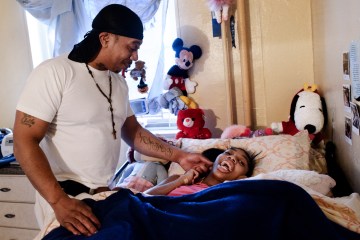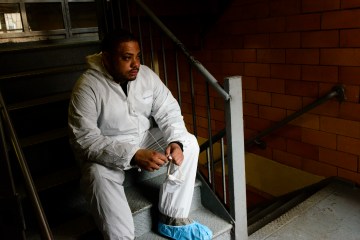Latoya Dickson (L) and her mother Edwyna Cannon, sit in a mold-infested bedroom of their apartment in the Redfern Houses in Far Rockaway, Queens, N.Y., on Nov. 30, 2012. For two weeks after Hurricane Sandy, Cannon and Dickson lived without electricity or heat.
When Edwyna Cannon welcomes visitors to her home these days, she starts by offering an apology. “I’m sorry about this,” she said as she walked down a short hallway to a back bedroom in her apartment in the Redfern Houses, a public housing project in the Far Rockaway section of Queens, NY that was in the direct path of Hurricane Sandy. “We have said sorry to everybody that came here,” her daughter, Latoya Dickson, added. “I know it’s not our fault, but we’re sorry.”
Standing in the doorway on a recent Friday, Cannon gazed around the bedroom and pointed to huge green and brown mold stains that blanketed the off-white walls, as if someone had splattered them with mud. “We tried to do as much as we could ourselves, but there was ice all over thesewalls,” she said. “This,” Dickson said, “is the horror of this house.”
(PHOTOS: Art for Sandy: Iconic, Collectable Photographs to Benefit Hurricane Sandy Relief)
When TIME visited Redfern two weeks after Sandy made landfall, most of the complex was still without power, heat and hot water (some buildings had generators powering hallway lights). The apartments were cold and dark and the walls looked like they were sweating from condensation. Nearly 1,800 people live at Redfern, a collection of 604 apartments spread across nine drab brick buildings not far from JFK Airport. The homes are on the Rockaway Peninsula, a coastal stretch of eastern New York City that was among the areas most devastated by the storm. Now, more than a month after Sandy, we returned to Redfern to see how residents of the hard-hit and long-neglected housing project are faring.

David Stephens plays with his daughter, Tatiana, in his apartment in the Redfern Houses in Far Rockaway, Queens, N.Y., on Nov. 30, 2012. David sent Tatiania, who suffered a brain infection that left her paralyzed, to live with his in-laws during the two weeks with no electricity after Sandy.
After 15 days in the dark, power was restored on Nov. 12. Heat followed a week later. (The New York City Housing Authority is rebating rent for every day without power, heat or elevator access. The average rent at Redfern is $472 a month.) There is still no hot water, but working electricity was enough for David Stephens to bring his family back. Stephens’ 17-year-old daughter, Tatiana, is paralyzed from a brain infection and she had just returned from one of her frequent surgeries the day Sandy hit. The following morning, Stephens carried the girl he calls Tati down six pitch-black flights of stairs to get her out of the building. Tati and her mother spent the next two weeks with relatives while Stephens stood guard in the apartment, wiping water from the near-frozen walls and reading Psalms to pass the time. The family reunion was short-lived when Tati’s throat closed-up a few days after she came back to Redfern, requiring another surgery. Now, after being away for weeks and enduring one more hospital trip, Tati lay in her room surrounded by stuffed animals with a broad smile on her face. “No matter what she goes through she just smiles,” Stephens said. “If she’s not complaining, I’m not complaining.”
Alfredo Otero, who lives on the sixth floor of a building near Redfern’s entrance, sent his wife and eight-year-old daughter Angelie to live with his son during the blackout. He stayed behind in the dank, frigid apartment to care for their five birds and three rescue dogs. For two weeks he barely left, fearing the animals would freeze and die. All of the animals survived and the family gathered around one, a giant cockatoo named Bocho, on a recent night as the bird danced to a Katy Perry song on the radio. “Oh, man, great, great,” Otero said of the scene, smiling under his again-working lights. But many of his neighbors aren’t as optimistic. “There’s a lot of people that they’re like, ‘we’ve had it. We’re moving away from Rockaway. We can’t take it anymore,” Otero said.
(PHOTOS: The Toil After the Storm: Life in Sandy’s Wake)
Residents’ anger over the lack of power and heat seems to have been replaced by concern about the mold that has been growing on their walls. The storm surge flooded Redfern, leaving behind a fetid, soppy mess of standing water and condensation on walls. Residents said the buildings have always been prone to mold, but the storm and resulting blackout drastically increased the problem. On the fourth floor of one of the buildings in the middle of the complex, Kenyatta Quarles walked around his cousin’s home, pointing out where mold had visibly infiltrated the walls. The apartment had the kind of warm, wet feel of a swampy riverbank. Quarles said that during the blackout it was so cold the floor felt like ice. “The walls sweat, but it got worse because of the capacity that the bricks were in-taking,” he said.

Derek Antoine, 32, a contract employee of Synergy, a mold remediation contractor hired by the New York City Housing Authority, rests in between cleaning units at the Redfern Houses in Far Rockaway, Queens, N.Y., on Nov. 30, 2012.
On the ground floor of 12-50 Redfern, Rebecca Glynn pointed to the ceiling of her bathroom where the mold had grown much worse in the weeks since I first saw it. Most of the walls contained brown splotches, and spores were now growing out of the ceiling. Water dripped from the bathroom doorframe. A leak? No, Glynn said, it was condensation from moisture building up in her apartment’s hot, sticky air.
“I’m not in a bad situation. I’m in a disgusting situation,” Glynn said. Three weeks ago, she described returning from work into the darkness as coming back to hell. When I asked how it felt now, she said, “It’s a little bit better now and people are calmed down. But coming here to this…” She waved her hand at her dripping walls and for the first time in 20 minutes, she was silent.
The city’s housing authority has been trying to remediate the mold. The agency said it contracted six private cleaning services, which in turn hired some 400 additional workers, to try to sanitize the public housing projects that were struck by the storm.
(MORE: After Sandy: Why We Can’t Keep Rebuilding on the Water’s Edge)
Shortly after 9 a.m. last Friday, dozens of those workers gathered at Redfern’s western entrance, where water from the nearby Motts Basin had poured across Beach Chanel Drive and submerged the three-foot tall fence surrounding the complex. The workers, who said they are paid $15 an hour, come from many of the areas hit hard by the storm. Clad in white haz mat suits, the workers were going door-to-door applying Shockwave, an industrial-strength disinfectant and fungicide often used to sanitize hospital floors, to mold splotches using a wooden staff with a small, white towel clamped to the end. When they came out of a contaminated apartment, the towels were dark gray, with debris falling from the fabric.
Much of the cleanup still falls to residents. Randy Evans grew up in Redfern and now works as a maintenance man at its daycare center. Sandy’s floodwaters ran right through the building that houses the center, carrying much of what was inside with it. “Everything that was in the front of the school was in the back of the school,” Evans said. “The floor was the color of the bags,” he said, pointing to a pile of black garbage bags he had filled with debris. Outside by the playground, Evans stacked all of the furniture and toys that were too damaged to save. A purple tricycle lay upside down, half submerged in mud in front of a water-riddled toy kitchen set, a pile of broken toys waiting to be hauled away with the rest of the storm’s garbage.
When he first saw the center, Evans said he figured there was no way it could reopen. With the help of five volunteers, Evans wiped down every wall, stripped and polished the floors and placed any undamaged furniture where it was before the storm. The daycare center looks, miraculously, like a school again.
MORE: After Sandy: Why Burying the Power Lines Is a Lonely Fight

